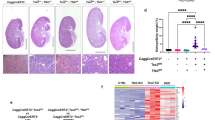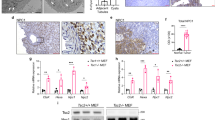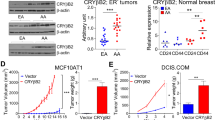Abstract
Tuberous sclerosis complex 1 (TSC1) and TSC2 are suppressors of mechanistic target of rapamycin (mTOR). mTOR is the major component of two protein complexes: mTOR complex 1 (mTORC1) and mTORC2. Inactive mutation of either TSC1 or TSC2 unleashes mTOR signaling and consequently causes TSC, a benign tumor syndrome affecting multiple organs. We report here that expression of αB-crystallin was upregulated in Tsc1−/− or Tsc2−/− mouse embryonic fibroblasts, Eker rat uterine leiomyoma-derived Tsc2-deficient ELT3 cells, mutant Tsc2-associated mouse kidney tumors, and human lung lymphangioleiomyomatosis nodules. αB-crystallin was transcriptionally activated by mTOR complex 2 (mTORC2): nuclear factor-kappa B (NFκB) signaling cascade. The augmented αB-crystallin was critical for the migration, invasion and apoptotic resistance of Tsc2-defective cells. Disruption of αB-crystallin suppressed Tsc2-null cell proliferation and tumorigenesis. Therefore, enhanced αB-crystallin has an essential role in TSC1/2 complex deficiency-mediated tumorigenesis, and inhibition of αB-crystallin may complement the current therapy for TSC.
This is a preview of subscription content, access via your institution
Access options
Subscribe to this journal
Receive 50 print issues and online access
$259.00 per year
only $5.18 per issue
Buy this article
- Purchase on Springer Link
- Instant access to full article PDF
Prices may be subject to local taxes which are calculated during checkout




Similar content being viewed by others
Accession codes
References
Guertin DA, Sabatini DM . Defining the role of mTOR in cancer. Cancer Cell 2007; 12: 9–22.
Hsieh AC, Liu Y, Edlind MP, Ingolia NT, Janes MR, Sher A et al. The translational landscape of mTOR signalling steers cancer initiation and metastasis. Nature 2012; 485: 55–61.
Ma J, Sun Q, Mi R, Zhang H . Avian influenza A virus H5N1 causes autophagy-mediated cell death through suppression of mTOR signaling. J Genet Genomics 2011; 38: 533–537.
Sun Q, Chen X, Ma J, Peng H, Wang F, Zha X et al. Mammalian target of rapamycin up-regulation of pyruvate kinase isoenzyme type M2 is critical for aerobic glycolysis and tumor growth. Proc Natl Acad Sci USA 2011; 108: 4129–4134.
Kwiatkowski DJ, Zhang H, Bandura JL, Heiberger KM, Glogauer M, el-Hashemite N et al. A mouse model of TSC1 reveals sex-dependent lethality from liver hemangiomas, and up-regulation of p70S6 kinase activity in Tsc1 null cells. Hum Mol Genet 2002; 11: 525–534.
Potter CJ, Pedraza LG, Xu T . Akt regulates growth by directly phosphorylating Tsc2. Nat Cell Biol 2002; 4: 658–665.
Inoki K, Li Y, Zhu T, Wu J, Guan KL . TSC2 is phosphorylated and inhibited by Akt and suppresses mTOR signalling. Nat Cell Biol 2002; 4: 648–657.
Manning BD, Tee AR, Logsdon MN, Blenis J, Cantley LC . Identification of the tuberous sclerosis complex-2 tumor suppressor gene product tuberin as a target of the phosphoinositide 3-kinase/akt pathway. Mol Cell 2002; 10: 151–162.
Holz MK, Ballif BA, Gygi SP, Blenis J . mTOR and S6K1 mediate assembly of the translation preinitiation complex through dynamic protein interchange and ordered phosphorylation events. Cell 2005; 123: 569–580.
Loewith R, Jacinto E, Wullschleger S, Lorberg A, Crespo JL, Bonenfant D et al. Two TOR complexes, only one of which is rapamycin sensitive, have distinct roles in cell growth control. Mol Cell 2002; 10: 457–468.
Hara K, Maruki Y, Long X, Yoshino K, Oshiro N, Hidayat S et al. Raptor, a binding partner of target of rapamycin (TOR), mediates TOR action. Cell 2002; 110: 177–189.
Kim DH, Sarbassov DD, Ali SM, King JE, Latek RR, Erdjument-Bromage H et al. mTOR interacts with raptor to form a nutrient-sensitive complex that signals to the cell growth machinery. Cell 2002; 110: 163–175.
Gingras AC, Raught B, Sonenberg N . Regulation of translation initiation by FRAP/mTOR. Genes Dev 2001; 15: 807–826.
Sarbassov DD, Ali SM, Kim DH, Guertin DA, Latek RR, Erdjument-Bromage H et al. Rictor, a novel binding partner of mTOR, defines a rapamycin-insensitive and raptor-independent pathway that regulates the cytoskeleton. Curr Biol 2004; 14: 1296–1302.
The European Chromosome 16 Tuberous Sclerosis Consortium, Identification and characterization of the tuberous sclerosis gene on chromosome 16. Cell 1993; 75: 1305–1315.
van Slegtenhorst M, de Hoogt R, Hermans C, Nellist M, Janssen B, Verhoef S et al. Identification of the tuberous sclerosis gene TSC1 on chromosome 9q34. Science 1997; 277: 805–808.
Zhang H, Cicchetti G, Onda H, Koon HB, Asrican K, Bajraszewski N et al. Loss of Tsc1/Tsc2 activates mTOR and disrupts PI3K-Akt signaling through downregulation of PDGFR. J Clin Invest 2003; 112: 1223–1233.
El-Hashemite N, Zhang H, Henske EP, Kwiatkowski DJ . Mutation in TSC2 and activation of mammalian target of rapamycin signalling pathway in renal angiomyolipoma. Lancet 2003; 361: 1348–1349.
Roach ES, Gomez MR, Northrup H . Tuberous sclerosis complex consensus conference: revised clinical diagnostic criteria. J Child Neurol 1998; 13: 624–628.
Carsillo T, Astrinidis A, Henske EP . Mutations in the tuberous sclerosis complex gene TSC2 are a cause of sporadic pulmonary lymphangioleiomyomatosis. Proc Natl Acad Sci USA 2000; 97: 6085–6090.
Bittmann I, Rolf B, Amann G, Lohrs U . Recurrence of lymphangioleiomyomatosis after single lung transplantation: new insights into pathogenesis. Hum Pathol 2003; 34: 95–98.
Iwaki T, Tateishi J . Immunohistochemical demonstration of alphaB-crystallin in hamartomas of tuberous sclerosis. Am J Pathol 1991; 139: 1303–1308.
Kupsky WJ, Frosch M . Tuberous sclerosis variant with production of Rosenthal fibers (alpha B-crystallin). Pediatr Pathol 1993; 13: 869–873.
Parcellier A, Schmitt E, Brunet M, Hammann A, Solary E, Garrido C . Small heat shock proteins HSP27 and alphaB-crystallin: cytoprotective and oncogenic functions. Antioxid Redox Signal 2005; 7: 404–413.
Mao YW, Liu JP, Xiang H, Li DW . Human alphaA- and alphaB-crystallins bind to Bax and Bcl-X(S) to sequester their translocation during staurosporine-induced apoptosis. Cell Death Differ 2004; 11: 512–526.
Kamradt MC, Lu M, Werner ME, Kwan T, Chen F, Strohecker A et al. The small heat shock protein alpha B-crystallin is a novel inhibitor of TRAIL-induced apoptosis that suppresses the activation of caspase-3. J Biol Chem 2005; 280: 11059–11066.
Aoyama A, Steiger RH, Frohli E, Schafer R, von Deimling A, Wiestler OD et al. Expression of alpha B-crystallin in human brain tumors. Int J Cancer 1993; 55: 760–764.
Shi T, Dong F, Liou LS, Duan ZH, Novick AC, DiDonato JA . Differential protein profiling in renal-cell carcinoma. Mol Carcinog 2004; 40: 47–61.
Sitterding SM, Wiseman WR, Schiller CL, Luan C, Chen F, Moyano JV et al. AlphaB-crystallin: a novel marker of invasive basal-like and metaplastic breast carcinomas. Ann Diagn Pathol 2008; 12: 33–40.
Young LR, Inoue Y, McCormack FX . Diagnostic potential of serum VEGF-D for lymphangioleiomyomatosis. N Engl J Med 2008; 358: 199–200.
Howe SR, Gottardis MM, Everitt JI, Goldsworthy TL, Wolf DC, Walker C . Rodent model of reproductive tract leiomyomata. Establishment and characterization of tumor-derived cell lines. Am J Pathol 1995; 146: 1568–1579.
Yu K, Toral-Barza L, Shi C, Zhang WG, Lucas J, Shor B et al. Biochemical, cellular, and in vivo activity of novel ATP-competitive and selective inhibitors of the mammalian target of rapamycin. Cancer Res 2009; 69: 6232–6240.
Goncharova EA, Goncharov DA, Li H, Pimtong W, Lu S, Khavin I et al. mTORC2 is required for proliferation and survival of TSC2-null cells. Mol Cell Biol 2011; 31: 2484–2498.
Karin M . Nuclear factor-kappaB in cancer development and progression. Nature 2006; 441: 431–436.
Ozes ON, Mayo LD, Gustin JA, Pfeffer SR, Pfeffer LM, Donner DB . NF-kappaB activation by tumour necrosis factor requires the Akt serine-threonine kinase. Nature 1999; 401: 82–85.
Dan HC, Cooper MJ, Cogswell PC, Duncan JA, Ting JP, Baldwin AS . Akt-dependent regulation of NF-{kappa}B is controlled by mTOR and Raptor in association with IKK. Genes Dev 2008; 22: 1490–1500.
Ma J, Meng Y, Kwiatkowski DJ, Chen X, Peng H, Sun Q et al. Mammalian target of rapamycin regulates murine and human cell differentiation through STAT3/p63/Jagged/Notch cascade. J Clin Invest 2010; 120: 103–114.
Lang SA, Hackl C, Moser C, Fichtner-Feigl S, Koehl GE, Schlitt HJ et al. Implication of RICTOR in the mTOR inhibitor-mediated induction of insulin-like growth factor-I receptor (IGF-IR) and human epidermal growth factor receptor-2 (Her2) expression in gastrointestinal cancer cells. Biochim Biophys Acta 2010; 1803: 435–442.
Tanaka K, Babic I, Nathanson D, Akhavan D, Guo D, Gini B et al. Oncogenic EGFR signaling activates an mTORC2-NF-kappaB pathway that promotes chemotherapy resistance. Cancer Discov 2011; 1: 524–538.
Ousman SS, Tomooka BH, van Noort JM, Wawrousek EF, O'Connor KC, Hafler DA et al. Protective and therapeutic role for alphaB-crystallin in autoimmune demyelination. Nature 2007; 448: 474–479.
Bhaskar PT, Nogueira V, Patra KC, Jeon SM, Park Y, Robey RB et al. mTORC1 hyperactivity inhibits serum deprivation-induced apoptosis via increased hexokinase II and GLUT1 expression, sustained Mcl-1 expression, and glycogen synthase kinase 3beta inhibition. Mol Cell Biol 2009; 29: 5136–5147.
Lamb RF, Roy C, Diefenbach TJ, Vinters HV, Johnson MW, Jay DG et al. The TSC1 tumour suppressor hamartin regulates cell adhesion through ERM proteins and the GTPase Rho. Nat Cell Biol 2000; 2: 281–287.
Astrinidis A, Cash TP, Hunter DS, Walker CL, Chernoff J, Henske EP . Tuberin, the tuberous sclerosis complex 2 tumor suppressor gene product, regulates Rho activation, cell adhesion and migration. Oncogene 2002; 21: 8470–8476.
Lee L, Sudentas P, Donohue B, Asrican K, Worku A, Walker V et al. Efficacy of a rapamycin analog (CCI-779) and IFN-gamma in tuberous sclerosis mouse models. Genes Chromosomes Cancer 2005; 42: 213–227.
Bissler JJ, McCormack FX, Young LR, Elwing JM, Chuck G, Leonard JM et al. Sirolimus for angiomyolipoma in tuberous sclerosis complex or lymphangioleiomyomatosis. N Engl J Med 2008; 358: 140–151.
Krueger DA, Care MM, Holland K, Agricola K, Tudor C, Mangeshkar P et al. Everolimus for subependymal giant-cell astrocytomas in tuberous sclerosis. N Engl J Med 2010; 363: 1801–1811.
McCormack FX, Inoue Y, Moss J, Singer LG, Strange C, Nakata K et al. Efficacy and safety of sirolimus in lymphangioleiomyomatosis. N Engl J Med 2011; 364: 1595–1606.
Hosoi H, Dilling MB, Liu LN, Danks MK, Shikata T, Sekulic A et al. Studies on the mechanism of resistance to rapamycin in human cancer cells. Mol Pharmacol 1998; 54: 815–824.
Zhang H, Bajraszewski N, Wu E, Wang H, Moseman AP, Dabora SL et al. PDGFRs are critical for PI3K/Akt activation and negatively regulated by mTOR. J Clin Invest 2007; 117: 730–738.
Acknowledgements
This study was supported by National Basic Research Program of China 973 Program Grants 2009CB522203 and 2011CB965002 and National Natural Science Foundation of China Grants 81130085 and 81101516.
Author information
Authors and Affiliations
Corresponding author
Ethics declarations
Competing interests
The authors declare no conflict of interest.
Additional information
Supplementary Information accompanies this paper on the Oncogene website
Supplementary information
Rights and permissions
About this article
Cite this article
Wang, F., Chen, X., Li, C. et al. Pivotal role of augmented αB-crystallin in tumor development induced by deficient TSC1/2 complex. Oncogene 33, 4352–4358 (2014). https://doi.org/10.1038/onc.2013.401
Received:
Revised:
Accepted:
Published:
Issue Date:
DOI: https://doi.org/10.1038/onc.2013.401



